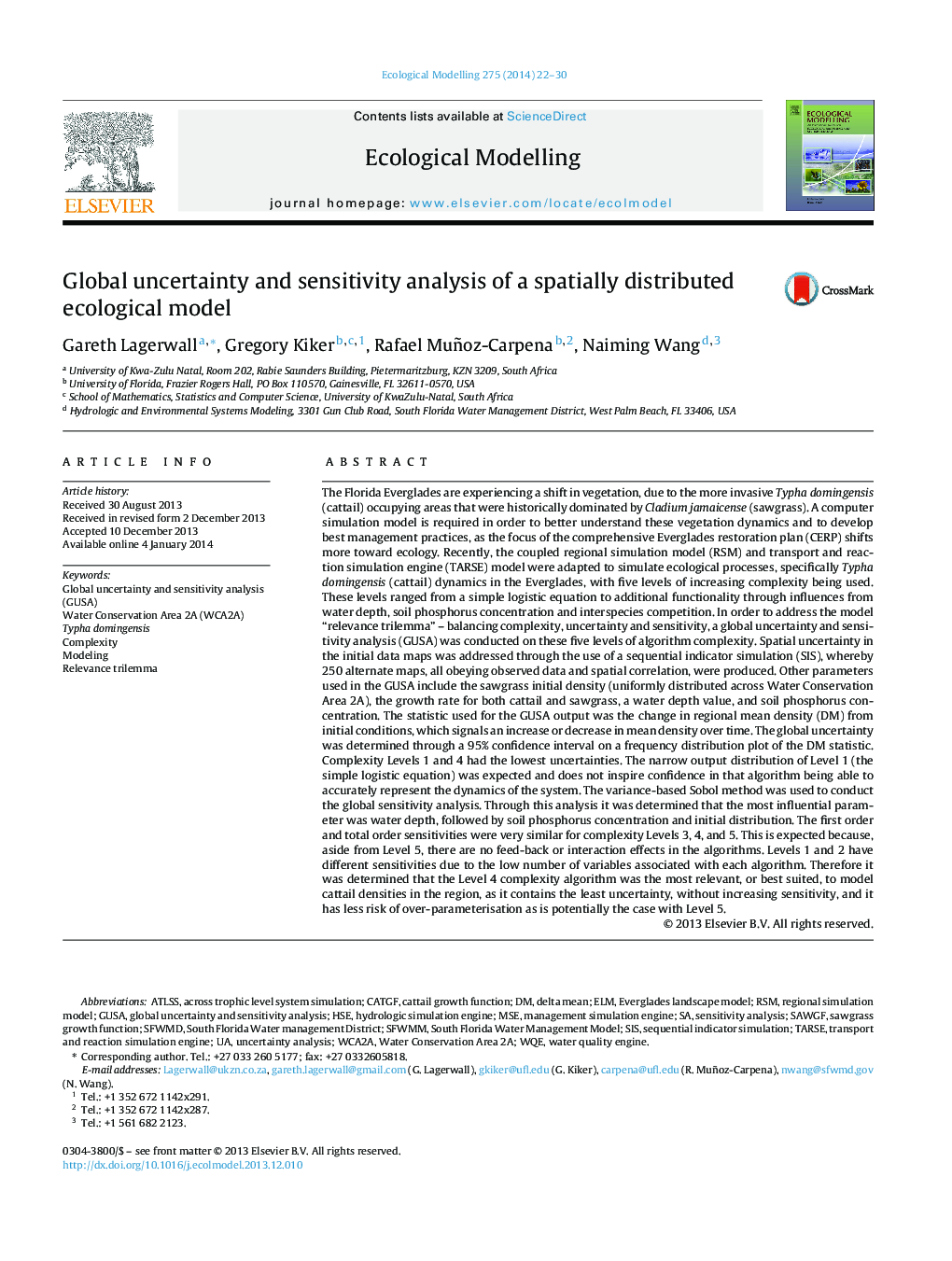| کد مقاله | کد نشریه | سال انتشار | مقاله انگلیسی | نسخه تمام متن |
|---|---|---|---|---|
| 4375999 | 1617471 | 2014 | 9 صفحه PDF | دانلود رایگان |
• Modeled Typha domingensis (Cattail) distribution in a controlled wetland in Florida.
• Multiple algorithms of increasing complexity were simulated simultaneously.
• Performed a global uncertainty and sensitivity analysis using the method of Sobol.
• Used sequential indicator simulation to account for spatial heterogeneity.
• The relevance trilemma was tested – balancing complexity, uncertainty and sensitivity.
The Florida Everglades are experiencing a shift in vegetation, due to the more invasive Typha domingensis (cattail) occupying areas that were historically dominated by Cladium jamaicense (sawgrass). A computer simulation model is required in order to better understand these vegetation dynamics and to develop best management practices, as the focus of the comprehensive Everglades restoration plan (CERP) shifts more toward ecology. Recently, the coupled regional simulation model (RSM) and transport and reaction simulation engine (TARSE) model were adapted to simulate ecological processes, specifically Typha domingensis (cattail) dynamics in the Everglades, with five levels of increasing complexity being used. These levels ranged from a simple logistic equation to additional functionality through influences from water depth, soil phosphorus concentration and interspecies competition. In order to address the model “relevance trilemma” – balancing complexity, uncertainty and sensitivity, a global uncertainty and sensitivity analysis (GUSA) was conducted on these five levels of algorithm complexity. Spatial uncertainty in the initial data maps was addressed through the use of a sequential indicator simulation (SIS), whereby 250 alternate maps, all obeying observed data and spatial correlation, were produced. Other parameters used in the GUSA include the sawgrass initial density (uniformly distributed across Water Conservation Area 2A), the growth rate for both cattail and sawgrass, a water depth value, and soil phosphorus concentration. The statistic used for the GUSA output was the change in regional mean density (DM) from initial conditions, which signals an increase or decrease in mean density over time. The global uncertainty was determined through a 95% confidence interval on a frequency distribution plot of the DM statistic. Complexity Levels 1 and 4 had the lowest uncertainties. The narrow output distribution of Level 1 (the simple logistic equation) was expected and does not inspire confidence in that algorithm being able to accurately represent the dynamics of the system. The variance-based Sobol method was used to conduct the global sensitivity analysis. Through this analysis it was determined that the most influential parameter was water depth, followed by soil phosphorus concentration and initial distribution. The first order and total order sensitivities were very similar for complexity Levels 3, 4, and 5. This is expected because, aside from Level 5, there are no feed-back or interaction effects in the algorithms. Levels 1 and 2 have different sensitivities due to the low number of variables associated with each algorithm. Therefore it was determined that the Level 4 complexity algorithm was the most relevant, or best suited, to model cattail densities in the region, as it contains the least uncertainty, without increasing sensitivity, and it has less risk of over-parameterisation as is potentially the case with Level 5.
Journal: Ecological Modelling - Volume 275, 10 March 2014, Pages 22–30
